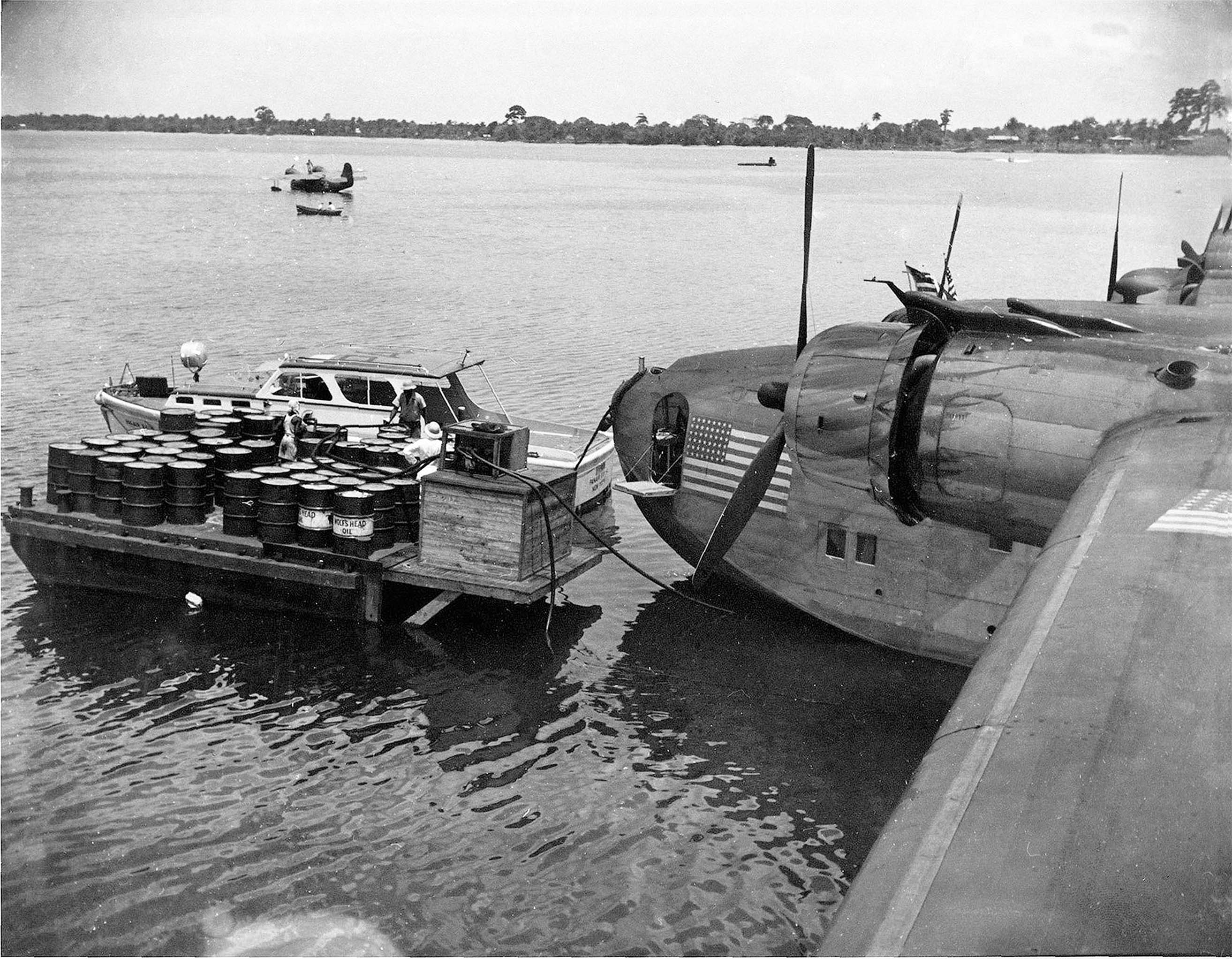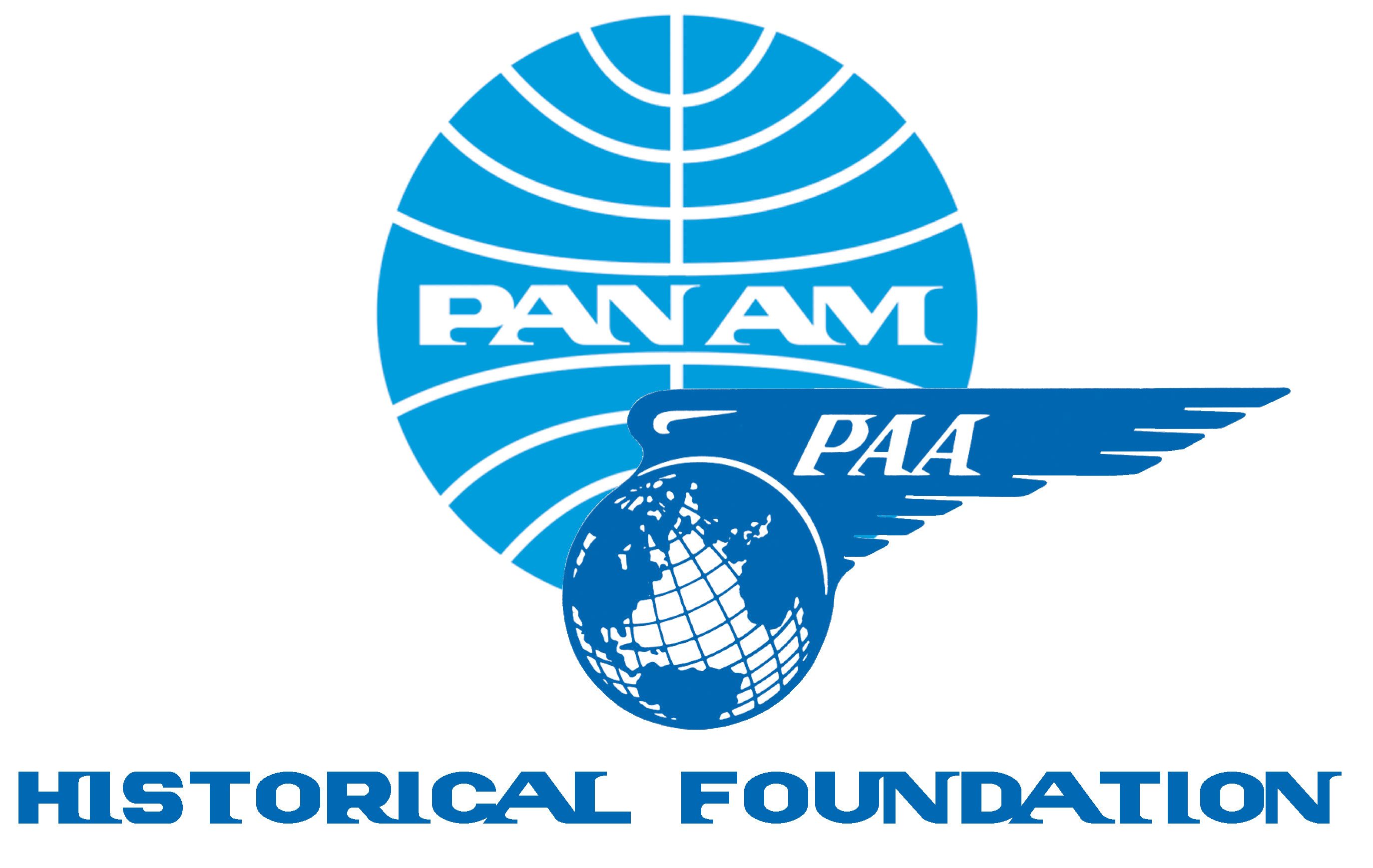U.S. AT WAR
1941-1945

THE WAR GETS CLOSER
TRIPPE'S TRANSATLANTIC JOURNEY
In June 1941, before the U.S. got into the war, Juan Trippe flew to London to present a lecture to the Royal Aeronautical Society. His talk was entitled "Ocean Air Transport." This was not just a technical review. It was both a review of how far Pan Am had come, as well as a detailed description of current methods used by Pan American B-314 crews to fly the Atlantic.
Juan Trippe (left) returns from his trip to London after his address to the Royal Aeronautical Society and his meeting with Winston Churchill in June 1941 (Pan Am Annual Report 1942).
And towards the end of the speech, Trippe talked about what was to come. He said that the future would demand airplanes that would permit "continent-to-continent non-stop operation." Enumerating the problems faced in particular by transatlantic flying boats — winter winds aloft, and icy conditions on shore, waves at Horta, a fuel stop for flights across the Atlantic, and imperfect weather forecasting — Trippe was plainly looking forward to next steps. That leap, it was obvious, was not going to involve flying boats. He asked in conclusion, "Who would be bold enough to predict the distant future?" Obviously, Juan Trippe himself was deeply involved in thinking about the future and was helping to bring it about, once the war was over. In June 1941, that seemed a long ways off.
Transatlantic meteorological charts were essential, but not always accurate (May 1941).
Transatlantic meteorological charts were essential, but not always accurate (May 1941).
TRIPPE CONFERS WITH CHURCHILL
With the lecture over, Trippe found himself invited to dinner with the Prime Minister, Winston Churchill. Even before he arrived in England, Trippe had already talked with Army and government officials about opening an air route across the South Atlantic to supply aircraft to British forces fighting in North Africa. Now Trippe had the chance to explain this in detail with Churchill. When he returned to the US, Trippe immediately went to see FDR to share what had been discussed.
GLOBAL WAR
On December 7 1941, Japan attached Pearl Harbor, six months after Hitler's armies invaded Russia. The US was pulled into the war that now spread across the globe. Pan Am could now dispense with the niceties of neutrality. Its personnel and planes were soon flying under military contracts, under wartime security. At the war's start, Pan Am offered the only option for over-ocean air transport, conducting critical cargo missions throughout the war, often flying through hostile territories and risking enemy interception.

PAN AM AIR FERRIES
The new network of airfields constructed under the Airport Development Program (ADP) in northeastern Brazil became vital for Allied operations. Pilots hired by Pan Am would ferry US warplanes from Brazil to Africa. From there, the route would follow an older British air route across to Sudan, where British pilots could fly them to the North African combat zone. Later, the same path would be extended to link far-off India and China. On August 18th, having just returned from a shipboard conference with Prime Minister Churchill in Newfoundland, FDR announced the plan. Pan American Air Ferries was underway. America was not yet at war, but Pan Am was.
PAA AIR FERRIES - AFRICA
Pan Am Air Ferries Building in Miami, WW2 (Pete Goutiere collection).
Pan Am Air Ferries Building in Miami, WW2 (Pete Goutiere collection).
WW2 photo from Pan Am Air Ferries in Africa (Pete Goutiere collection).
WW2 photo from Pan Am Air Ferries in Africa (Pete Goutiere collection).
A Pan American Air Ferries image in Africa, World War Two (Pete Goutiere collection).
A Pan American Air Ferries image in Africa, World War Two (Pete Goutiere collection).
PAA Air Ferries employees in Africa, World War Two (Pete Goutiere collection).
PAA Air Ferries employees in Africa, World War Two (Pete Goutiere collection).

WW2 AIRCRAFT IN BOWERY BAY BY THE MARINE AIR TERMINAL
Bowery Bay, Marine Air Terminal, filled with Naval Air Transport Service aircraft after the U.S. entered World War Two (Courtesy AeroArt International).
Bowery Bay, Marine Air Terminal, filled with Naval Air Transport Service aircraft after the U.S. entered World War Two (Courtesy AeroArt International).
Civilian and military passengers board at B-314 Clipper in "warpaint" at the Marine Air Terminal during US involvement in WW2 (Courtesy AeroArt International).
Civilian and military passengers board at B-314 Clipper in "warpaint" at the Marine Air Terminal during US involvement in WW2 (Courtesy AeroArt International).
Many Naval Air Transport Service flights were operated by Pan Am Crews. Photo shows a NATS Coronado docked at the Marine Air Terminal (Courtesy Aeroart International).
Many Naval Air Transport Service flights were operated by Pan Am Crews. Photo shows a NATS Coronado docked at the Marine Air Terminal (Courtesy Aeroart International).
PAN AM JOINS THE WAR EFFORT
"Here in the jig shop at one of Pan American' s great repair hangars at a main base, skilled mechanics build up an engine for one of the transocean Clippers." (Pan Am Annual Report 1943, University of Miami, Special Collections).
"Here in the jig shop at one of Pan American' s great repair hangars at a main base, skilled mechanics build up an engine for one of the transocean Clippers." (Pan Am Annual Report 1943, University of Miami, Special Collections).
"Their work is vital. These Pan American women mechanics, who replaced men, are giving the final check to propellers serviced in the overhaul shop." (Pan Am Annual Report 1943, University of Miami, Special Collections).
"Their work is vital. These Pan American women mechanics, who replaced men, are giving the final check to propellers serviced in the overhaul shop." (Pan Am Annual Report 1943, University of Miami, Special Collections).
Loading Pan Am Cargo at the Marine Air Terminal (Eric Sorensen collection).
Loading Pan Am Cargo at the Marine Air Terminal (Eric Sorensen collection).

PAN AM TRAINING PROGRAM: A NAVIGATION CLASS STANDS BESIDE A PAN AM SIKORSKY AT DINNER KEY, MIAMI (Aeroart International).
PAN AM TRAINING PROGRAM: A NAVIGATION CLASS STANDS BESIDE A PAN AM SIKORSKY AT DINNER KEY, MIAMI (Aeroart International).
PAN AM WARTIME NAVIGATION TRAINING AT DINNER KEY (Aeroart International).
PAN AM WARTIME NAVIGATION TRAINING AT DINNER KEY (Aeroart International).
SPECIAL MISSIONS
Pan Am M-130 China Clipper in camouflage, Trinidad, 1944 (Pan Am Historical Foundation collection).
Pan Am M-130 China Clipper in camouflage, Trinidad, 1944 (Pan Am Historical Foundation collection).
Arduous special missions for the armed services and government were common. Pan Am planes were used to transport high-profile individuals, including President Franklin Roosevelt, to important wartime conferences. These flights, while not combat missions, carried significant risk due to their high-value targets. The airline flew the president to and from Africa for the Casablanca Conference in January, 1943. Later in the war, in a highly secretive mission, the China Clipper was tasked to bring uranium back from the Belgian Congo for the Manhattan Project. In January 1945, the plane crashed on approach to Trinidad from the Congo. As the war went on, Pan Am was joined by other entities capable of transoceanic airlift, such as American Export Airlines, and the Army Air Transport Command (ATC).
But Pan Am was an essential player in the eventual Allied victory. Pan American crews flew military transports, trained navigators and mechanics for the armed services, operated and maintained route infrastructure around the world, and pioneered routes that were followed later by the US military.

LISTEN
1942 An American in England radio drama
"CLIPPER HOME"
An American in England radio drama: "Clipper Home" produced by Norman Corwin, 1942 (Archive.org).

VIDEO
JUAN TRIPPE SPEAKS ABOUT AVIATION'S FUTURE 1943
Juan Trippe speaking about the postwar future of air travel, 1943. Filmed as part of a "March of Time" episode (US National Archives).
THE YANKEE CLIPPER
The crash of the Yankee Clipper in Lisbon in February 1943 was a tragic loss for both Pan American and the nation. Even though it happened in time of war when human loss and suffering were all too common, the event still came as a shock - an unwelcome reminder that tragedy can strike, and lives can be cut short without warning. The crash is still remembered today. A recent book, by Brooke Blower, "Americans in Time of War — Intimate Histories from the Crash of the Yankee Clipper," traces the stories of some of those on board that day. Preview the book
"Americans in a World at War: Intimate Histories from the Crash of Pan Am's Yankee Clipper," by Brooke L. Blower.
"Americans in a World at War: Intimate Histories from the Crash of Pan Am's Yankee Clipper," by Brooke L. Blower.
POSTWAR UNCERTAINTY
As the war progressed, questions arose about the postwar reinstatement of Pan American's former status as America's only international airline. Domestic airlines were contributing aircraft and crews to the ATC.
The postwar civil aviation space would soon be awash with surplus transport aircraft like the new C-54/DC-4, which had transoceanic capabilities. Veteran air crews would be available to fly international routes. The postwar world could bring new opportunities in the international field. The US government was not willing to go back to the way things were before the war, and Pan American's once special status as America's sole international air carrier was not likely to return.
Air Transport Command C-54 at Pan Am's Miami facility (Courtesy of AeroArt International).
Air Transport Command C-54 at Pan Am's Miami facility (Courtesy of AeroArt International).
As the war's inevitable end drew closer, it was clear that some sort of arrangement would be necessary for international civil aviation. A conference was held in Chicago in 1944 to explore these topics, and it became clear that there was going to be a return of the prewar friction over international air routes.
Prospective Post War Air Routes for Commercial Aviation (Aeroart International collection).
Prospective Post War Air Routes for Commercial Aviation (Aeroart International collection).
But as he had in the past, Juan Trippe's sights were set on keeping Pan Am at the leading edge of aviation. He was ready for the postwar world with new aircraft, new markets, and new business models. As in the past, the Atlantic would be a prime focus. It would remain the biggest market and present the biggest opportunity.
1944 REVIEW
When the NATS contract expired in January of 1944, Pan Am Atlantic Division announced that Pan Am was resuming commercial service, with scheduled service to Europe and Africa. The company was already considering purchase of Douglas DC-7s.

BACK IN BUSINESS
Pan Atlantic Clipper January 4, 1945, "Read on four continents and four islands in between" (University of Miami Special Collections).
Pan Atlantic Clipper January 4, 1945, "Read on four continents and four islands in between" (University of Miami Special Collections).
Pan American World Airways Time Table, Atlantic, June 1945 (University of Miami Special Collections).
Pan American World Airways Time Table, Atlantic, June 1945 (University of Miami Special Collections).





















